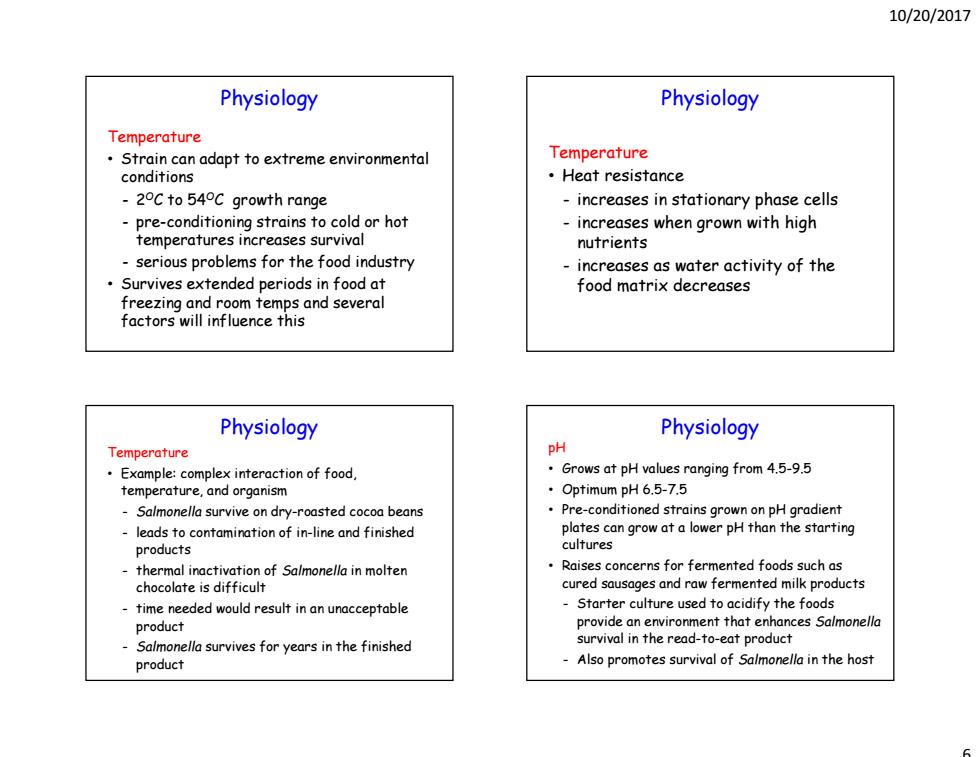
10/20/2017 Physiology Physiology Temperature Strain can adapt to extreme environmental Temperature conditions ·Heat resistance -20C to 540c growth range increases in stationary phase cells pre-conditioning strains to cold or hot -increases when grown with high femperatures increases survival nutrients serious problems for the food industry increases as water activity of the Survives extended periods in food at food matrix decreases freezing and room temps and several factors will influence this Physiology Physiology Temperature pH Example:complex interaction of food, Grows at pH values ranging from 4.5-9.5 temperature,and organism ·Optimum pH6.5-7.5 -Salmonella survive on dry-roasted cocoa beans Pre-conditioned strains grown on pH gradient leads to contamination of in-line and finished plates can grow at a lower pH than the starting products cultures thermal inactivation of Salmonella in molten Raises concerns for fermented foods such as chocolate is difficult cured sausages and raw fermented milk products time needed would result in an unacceptable Starter culture used to acidify the foods product provide an environment that enhances Salmonella Salmonella survives for years in the finished survival in the read-to-eat product product Also promotes survival of Salmonella in the host
10/20/2017 6 Physiology Temperature • Strain can adapt to extreme environmental conditions - 2OC to 54OC growth range - pre-conditioning strains to cold or hot temperatures increases survival - serious problems for the food industry • Survives extended periods in food at freezing and room temps and several factors will influence this Physiology Temperature • Heat resistance - increases in stationary phase cells - increases when grown with high nutrients - increases as water activity of the food matrix decreases Physiology Temperature • Example: complex interaction of food, temperature, and organism - Salmonella survive on dry-roasted cocoa beans - leads to contamination of in-line and finished products - thermal inactivation of Salmonella in molten chocolate is difficult - time needed would result in an unacceptable product - Salmonella survives for years in the finished product Physiology pH • Grows at pH values ranging from 4.5-9.5 • Optimum pH 6.5-7.5 • Pre-conditioned strains grown on pH gradient plates can grow at a lower pH than the starting cultures • Raises concerns for fermented foods such as cured sausages and raw fermented milk products - Starter culture used to acidify the foods provide an environment that enhances Salmonella survival in the read-to-eat product - Also promotes survival of Salmonella in the host

10/20/2017 Acid survival responses in enteric microorganisms Acid stress enhances resistance to other adverse Physiology environmental conditions Osmolarity Lysine Foods with water activity <0.93 do not support growth of salmonellae Growth is inhibited in 3-4%NaCl +Inducible decarboxylases Salt tolerance though increases with increasing temperature 'a→RpoS→ASPs Salt in acidified foods can reduce the PhoP一AsPs tect/Repa antibacterial action of organic acids →ASPs Anaerobic conditions associated with vacuum packed foods may enhance salt tolerance in ASPs Salmonella FE5 Lett19971471-80 Reservoirs Reservoirs Poultry meat and eggs are predominant Salmonella will continue to be a significant reservoirs of Salmonella spp.in many countries human pathogen in the global market for USDA-FSIS requires meat and poultry several reasons industries to implement Hazard Analysis and 1.Presence in the environment Critical Control Point (HACCP)plans in all 2.Intensive farming practices in the meat. facilities fish,and shellfish industries FSIS conducts testing to verify that the 3.Recycling of slaughterhouse by-products HACCP plan is helping to control Salmonella on finished products into animal feeds Rate of Salmonella in meat has been reduce due to HACCP plans
10/20/2017 7 Acid survival responses in enteric microorganisms Acid stress enhances resistance to other adverse environmental conditions FEMS Microbiol Lett 1997;147:173-180 Physiology Osmolarity • Foods with water activity < 0.93 do not support growth of salmonellae • Growth is inhibited in 3-4% NaCl • Salt tolerance though increases with increasing temperature • Salt in acidified foods can reduce the antibacterial action of organic acids • Anaerobic conditions associated with vacuum packed foods may enhance salt tolerance in Salmonella Reservoirs Salmonella will continue to be a significant human pathogen in the global market for several reasons 1. Presence in the environment 2. Intensive farming practices in the meat, fish, and shellfish industries 3. Recycling of slaughterhouse by-products into animal feeds Reservoirs • Poultry meat and eggs are predominant reservoirs of Salmonella spp. in many countries • USDA – FSIS requires meat and poultry industries to implement Hazard Analysis and Critical Control Point (HACCP) plans in all facilities • FSIS conducts testing to verify that the HACCP plan is helping to control Salmonella on finished products • Rate of Salmonella in meat has been reduce due to HACCP plans